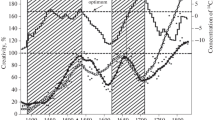Abstract—
The assertion that social upheaval tends to coincide with peaks of solar activity is the main result of A.L. Chizhevskii’s first famous work, published in 1924. The connection between solar activity and averaged indicators of the collective human mental state has since then been repeatedly verified by independent authors on various datasets and confirmed with certainty. However, all patterns revealed to date concern small spatial (about the size of a city) and huge time (about 10 years) scales of this correlation between solar activity and indicators of human mental states. In our research we attempt to extend proof of this correlation to a much smaller time scale and a much larger spatial scale. The effect of geomagnetic activity on the human nervous system is studied through investigating its correlation with frequencies of emotion-laden words in a database of posts from the scientific forum dxdy.ru in the years 2006–2016. A subset of emotion-laden words whose relative frequency correlates with the Kр-index at a level r = 0.4–0.6 with p < 0.0001 (p being the probability of obtaining a sample correlation coefficient of 0.4–0.6 if the true correlation between the series is zero) is identified.








Similar content being viewed by others
REFERENCES
Anuchin, V.I., Sotsial’nyi zakon: Zakon periodichnosti v narodnykh dvizheniyakh (Social Law (The Law of Periodicity in Popular Movements)), Tomsk, 1918.
Bekhterev, V.M., Kollektivnaya refleksologiya (Collective Reflexology), Petrograd, 1921. Binhi, V.N. and Savin, A.V., Effects of weak magnetic fields on biological systems: physical aspects, Phys.–Usp., 3003, vol. 46, pp. 259–291.
Bingi, V.N., Magnitobiologiya: Eksperimenty i modeli (Magnetobiology. Experiments and Models) Moscow: MILTA, 2002.
Breus, T.K., Binhi, V.N., and Petrukovich, A.A., Magnetic factor of the solar terrestrial relations and its impact on the human body: physical problems and prospects for research, Phys.–Usp., 2016, vol. 59, no. 5, pp. 502–510.
Breus, T.K., Gurfinkel, Yu.I., Zenchenko, T.A., and Ozheredov, V.A., Comparative analysis of different vascular tone sensitivity parameters to meteorological and geomagnetic factors, Izv., Atmos. Ocean. Phys., 2010, vol. 46, no. 8, pp. 965–972.
Breus, T.K., Vladimirskii, B.M., and Zelenyi, L.M., Unfinished debates. On the 120th anniversary of the birthday of A.L. Chizhevsky, Herald Russ. Acad. Sci., 2017, vol. 87, pp. 535–542.
Cherry, N., Schuman resonance, a plausible biophysical mechanism for the human health effects of solar geomagnetic activity, Nat. Hazards, 2002, vol. 26, pp. 279–331.
Chizhevskii, A.L., Fizicheskie faktory istoricheskogo protsessa (Physical Factors of the Historical Process), Kaluga: Assots. Kaluga-Mars; Gos. muzei istorii kosmonavtiki im. K.E. Tsiolkovskogo, 1990.
Ertel, S., Cosmophysical correlations of creative activity in culture history, Biophysics, 1998, vol. 43, no. 4, pp. 696–702.
Ertel, S., Space weather and revolutions: Chizevsky’s claim scrutinized, Stud. Psychol., 1996, vol. 38, no. 1/2, pp. 3–21.
Hsin-Chuan, K. and Ching-Hai, L., A directed genetic algorithm for global optimization, Appl. Math. Computation, 2013, vol. 219, no. 14–15, pp. 7348–7364. https://doi.org/10.1016/j.amc.2012.12.046
Ivanitskii, G.R., Medvinskii, A.B., and Tsyganov, M.A., From disorder to ordering, on the example of microorganism movement, Usp. Fiz. Nauk, 1994, vol. 164, pp. 1041–1072.
Kanunikov, I.E., Volkova, M.A., and Kiselev, B.V., The effect of geomagnetic field oscillations on the human EEG cheloveka, Tr. 7-i Pulkovskoi mezhdunar. konf. po fizike Solntsa (Proc. 7th Pulkovo Int. Conf. on Solar Physics), St. Petersburg, 2003, pp. 225–230.
Kirschvink, J.L., Kobayashi-Kirschvink, A., and Woodford, B.J., Magnetic biomineralization in the human brain, Proc. Natl. Acad. Sci. U. S. A., 1992, vol. 89, no. 8, pp. 7683–7687.
Korotaev, A.V., Bilyuga, S.E., Malkov, S.Yu., and Osipov, D.A., Solar activity as a possible factor of sociopolitical destabilization, Istor. Sovremennost’, 2016, no. 2, pp. 180–209.
Moré, T., Solntse i my (The Sun and Us), Petrograd, 1920.
Ozheredov, V.A., Chibisov, S.M., Blagonravov, M.L., et al., Influence of geomagnetic activity and earth weather changes on heart rate and blood pressure in young and healthy population, Int. J. Biometeorol., 2017, vol. 61, no. 5, pp. 921–929.
Pantin, V.I. and Lapkin, V.V., Istoricheskoe prognozirovanie v XXI veke: Tsikly Kondrat’eva, evolyutsionnye tsikly i perspektivy mirovogo razvitiya (Historical Forecasting in the 21st Century: Kondrat’ev’s Cycles, Evolutionary Cycles, and Prospects for Global Development), Dubna: Feniks, 2014.
Persinger, M. and Schaut, G., Geomagnetic factors in subjective telepathic, precognitive and postmortem experiences, J. Am. Soc. Phys. Res., 1998, vol. 82, pp. 217–235.
Putilov A.A. The uneven distribution of historical events within the 11-year solar cycle, Biofizika, 1992, vol. 57, no. 4, pp. 623–633.
Samokhvalov, V.P., The effect of cosmophysical fluctuations in mental diseases, Probl. Kosm. Biol., 1989, vol. 65, pp. 65–80.
Sidis, W.J., A remark on the occurrence of revolution, J. Abnorm. Psychol., 1918, vol. 13, pp. 213–228.
Starchenko A., Lyashevskaya O. A Cross-genre morphological tagging and lemmatization of the Russian poetry: Distinctive test sets and evaluation, in Digital Transformation and Global Society, vol. 138 of Commun. in Comp. and Inform. Sci., Alexandrov, D., Boukhanovsky, A., Chugunov, A., Kabanov, Y., Koltsova, O., and Musabirov, I., Eds., Cham: Springer, 2019. https://doi.org/10.1007/978-3-030-37858-5_62
Svyatskii, D.O., On a certain state of solar activity and popular revolts, Izv. Rus. obshch-va lyubitelei mirovedeniya, 1917, vol. 6, no. 6, pp. 310–312.
Turchin, P.V., Istoricheskaya dinamika: Na puti k teoreticheskoi istorii (Historical Dynamics: Toward Theoretical History), Moscow: URSS, 2007.
Vladimirsky, B.M., Solnechnaya aktivnost' i obshchestvennaya zhizn': Kosmicheskaya istoriometriya ot pervykh rossiiskikh kosmistov do nashikh dnei (Solar Activity and Social Life: Space Historiometry from the First Russsian Cosmists till Present), Moscow: URSS, 2013.
Author information
Authors and Affiliations
Corresponding author
Ethics declarations
The authors declare that there is no conflict of interest.
Additional information
Translated by A. Ovchinnikova
Rights and permissions
About this article
Cite this article
Ozheredov, V.A., Breus, T.K. & Zeleny, L.M. Connection between the Intellectual Excitability of Internet Users and Increases in Solar Activity. Izv. Atmos. Ocean. Phys. 56, 1346–1358 (2020). https://doi.org/10.1134/S0001433820110067
Received:
Revised:
Accepted:
Published:
Issue Date:
DOI: https://doi.org/10.1134/S0001433820110067




